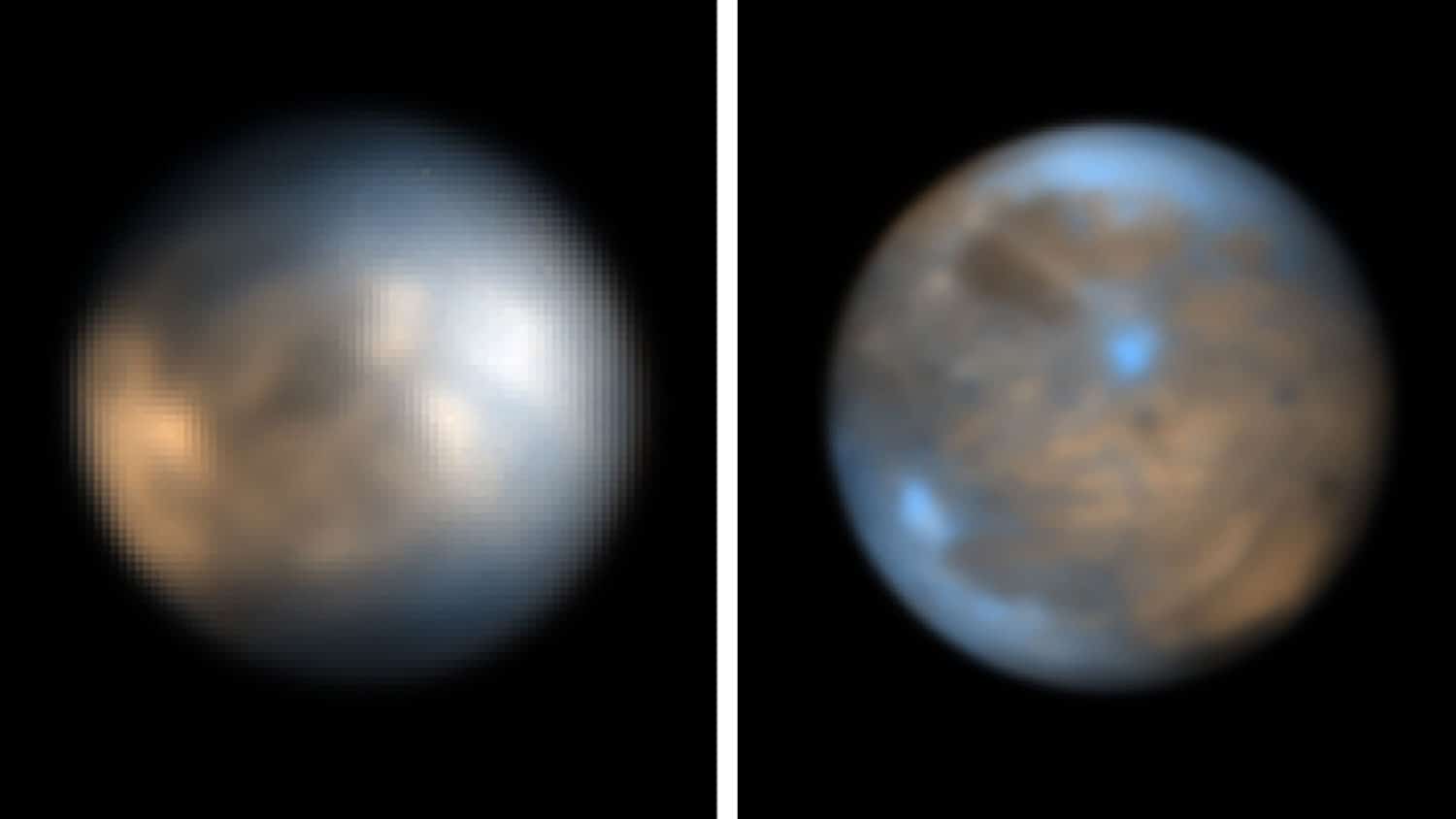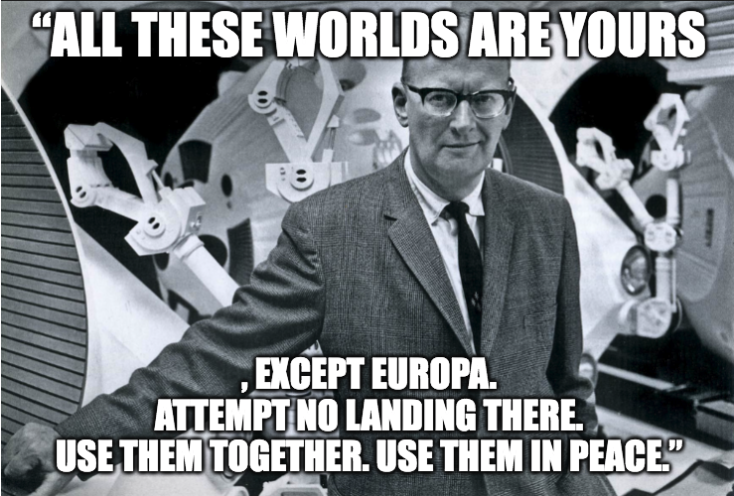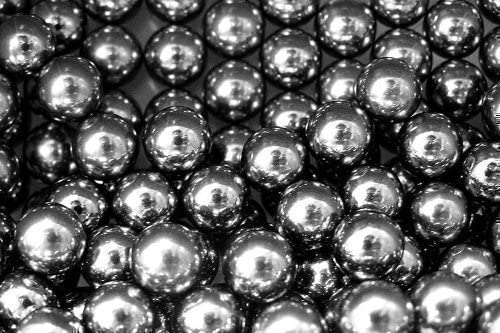It looks like you're using an Ad Blocker.
Please white-list or disable AboveTopSecret.com in your ad-blocking tool.
Thank you.
Some features of ATS will be disabled while you continue to use an ad-blocker.
12
share:
The two images were captured by the European Southern Observatory's Very Large Telescope based in Chile's Atacama Desert , they were taken so
astronomers can analyze the light spectrum to define the makeup of the Moons for future exploration missions

Europa has a thick ice shell with a water ocean beneath and Ganymede has a rocky ice shell with an internal ocean below and water ice at the surface , it's also the largest Moon in the Solar System (larger than Mercury) and has its own magnetic field ,although weak , which means it has a liquid core and as with Europa it probably has Hydrothermal vents ... the breeding ground for life.

Seen as blue-colored areas in the VLT image, the icy regions of Ganymede include its polar ice caps and craters where asteroid impacts have freshly exposed the ice that makes up the Galilean moon's crust. King and his colleagues also used the images to map the size of ice grains across Ganymede's surface and determine how different salts may be distributed over it.
"[The VLT] has allowed us to carry out detailed mapping of Europa and Ganymede, observing features on their surfaces smaller than 150 kilometers [90 miles] across — all at distances over 600 million kilometers [370 million miles] from the Earth," King said. "Mapping at this fine scale was previously only possible by sending spacecraft all the way to Jupiter to observe the moons up close."
This research doesn't mean that future missions to these moons are off the table, however. On the contrary, this mapping of Europa and Ganymede makes the prospect of these spacecraft missions even more enticing.
www.space.com...
Europa has a thick ice shell with a water ocean beneath and Ganymede has a rocky ice shell with an internal ocean below and water ice at the surface , it's also the largest Moon in the Solar System (larger than Mercury) and has its own magnetic field ,although weak , which means it has a liquid core and as with Europa it probably has Hydrothermal vents ... the breeding ground for life.
edit on 12-10-2022 by gortex because: (no reason
given)
originally posted by: gortex
The two images were captured by the European Southern Observatory's Very Large Telescope based in Chile's Atacama Desert , they were taken so astronomers can analyze the light spectrum to define the makeup of the Moons for future exploration missions
Seen as blue-colored areas in the VLT image, the icy regions of Ganymede include its polar ice caps and craters where asteroid impacts have freshly exposed the ice that makes up the Galilean moon's crust. King and his colleagues also used the images to map the size of ice grains across Ganymede's surface and determine how different salts may be distributed over it.
"[The VLT] has allowed us to carry out detailed mapping of Europa and Ganymede, observing features on their surfaces smaller than 150 kilometers [90 miles] across — all at distances over 600 million kilometers [370 million miles] from the Earth," King said. "Mapping at this fine scale was previously only possible by sending spacecraft all the way to Jupiter to observe the moons up close."
This research doesn't mean that future missions to these moons are off the table, however. On the contrary, this mapping of Europa and Ganymede makes the prospect of these spacecraft missions even more enticing.
www.space.com...
Europa has a thick ice shell with a water ocean beneath and Ganymede has a rocky ice shell with an internal ocean below and water ice at the surface , it's also the largest Moon in the Solar System (larger than Mercury) and has its own magnetic field ,although weak , which means it has a liquid core and as with Europa it probably has Hydrothermal vents ... the breeding ground for life.

originally posted by: putnam6
originally posted by: gortex
The two images were captured by the European Southern Observatory's Very Large Telescope based in Chile's Atacama Desert , they were taken so astronomers can analyze the light spectrum to define the makeup of the Moons for future exploration missions
Seen as blue-colored areas in the VLT image, the icy regions of Ganymede include its polar ice caps and craters where asteroid impacts have freshly exposed the ice that makes up the Galilean moon's crust. King and his colleagues also used the images to map the size of ice grains across Ganymede's surface and determine how different salts may be distributed over it.
"[The VLT] has allowed us to carry out detailed mapping of Europa and Ganymede, observing features on their surfaces smaller than 150 kilometers [90 miles] across — all at distances over 600 million kilometers [370 million miles] from the Earth," King said. "Mapping at this fine scale was previously only possible by sending spacecraft all the way to Jupiter to observe the moons up close."
This research doesn't mean that future missions to these moons are off the table, however. On the contrary, this mapping of Europa and Ganymede makes the prospect of these spacecraft missions even more enticing.
www.space.com...
Europa has a thick ice shell with a water ocean beneath and Ganymede has a rocky ice shell with an internal ocean below and water ice at the surface , it's also the largest Moon in the Solar System (larger than Mercury) and has its own magnetic field ,although weak , which means it has a liquid core and as with Europa it probably has Hydrothermal vents ... the breeding ground for life.
We're gonna Screw it all up by going to Europa. We always do.
That's incredible detail for Earth-observations, I guess they used the latest, most advanced adaptive optics to achieve this.
VLT can already see space stuff better than the Hubble.
VLT can already see space stuff better than the Hubble.
a reply to: wildespace
well duh the mirrors in the Hubble is from old spy sats from the 70's
new mirrors like what is on the JWT means we can make huge mirrors even on earth
well duh the mirrors in the Hubble is from old spy sats from the 70's
new mirrors like what is on the JWT means we can make huge mirrors even on earth
a reply to: carbonwaste
Webb is not an optical telescope so it doesn't use mirrors to see , it detects light in the infrared spectrum which gives it the ability to see through dust and gas clouds.
Hubble's mirror is fine.
well duh the mirrors in the Hubble is from old spy sats from the 70's
new mirrors like what is on the JWT means we can make huge mirrors even on earth
Webb is not an optical telescope so it doesn't use mirrors to see , it detects light in the infrared spectrum which gives it the ability to see through dust and gas clouds.
Hubble's mirror is fine.
edit on 13-10-2022 by gortex because: (no reason given)
a reply to: gortex
i was more referring to the distributed mirror set up
they have in the works a bigger sat that uses folded mirrors like JWT's mirrors
the bigger the mirror the better the resolution
I'm sure you know how much a precision piece of glass weighs and that's what limits the space sats we could put up until JWT.
not the specta it see's in
you can only make a single mirror so big before it is to big to launch
i was more referring to the distributed mirror set up
they have in the works a bigger sat that uses folded mirrors like JWT's mirrors
the bigger the mirror the better the resolution
I'm sure you know how much a precision piece of glass weighs and that's what limits the space sats we could put up until JWT.
not the specta it see's in
you can only make a single mirror so big before it is to big to launch
a reply to: carbonwaste
I like the idea of of putting a telescope on the far side of the Moon , it would be relatively easy to maintain and easy to upgrade , Webb is a beautiful thing but it's just one stray rock from disaster.
I like the idea of of putting a telescope on the far side of the Moon , it would be relatively easy to maintain and easy to upgrade , Webb is a beautiful thing but it's just one stray rock from disaster.
a reply to: gortex
its already been hit in the lower right(?) mirror like at 5 o'clock by a small 'something' but they were able to refocus the mirrors and its just fine
but yeah something bigger than a small grain of sand would vaporize it
i have always wondered if you could use the tech for solar sail to make a HUGE mirror
its already been hit in the lower right(?) mirror like at 5 o'clock by a small 'something' but they were able to refocus the mirrors and its just fine
but yeah something bigger than a small grain of sand would vaporize it
i have always wondered if you could use the tech for solar sail to make a HUGE mirror
edit on 13-10-2022 by carbonwaste because: (no reason given)
originally posted by: carbonwaste
a reply to: wildespace
well duh the mirrors in the Hubble is from old spy sats from the 70's
new mirrors like what is on the JWT means we can make huge mirrors even on earth
The problem is not so much the mirror size as the atmospheric turbulence. That's why they put the Hubble up into space - to escape the atmosphere. VLT has had huge mirrors for many years, but is only now catching up to the Hubble's resolution thanks to the new adaptive optics. www.eso.org...
originally posted by: gortex
a reply to: carbonwaste
well duh the mirrors in the Hubble is from old spy sats from the 70's
new mirrors like what is on the JWT means we can make huge mirrors even on earth
Webb is not an optical telescope so it doesn't use mirrors to see
Actually, it does. Mirrors can reflect and focus infrared light just fine. webb.nasa.gov...
a reply to: wildespace
I know.
www.abovetopsecret.com...
My point was it isn't an optical telescope.
I know.
www.abovetopsecret.com...
My point was it isn't an optical telescope.
edit on 14-10-2022 by gortex because: (no reason given)
new topics
-
Almost Home
Short Stories: 2 hours ago -
Kamala finally builds a wall...around her home in DC
Jokes, Puns, & Pranks: 3 hours ago -
Ok Melbourne, Really?
Music: 4 hours ago -
Predictions for the result
2024 Elections: 8 hours ago
top topics
-
Predictions for the result
2024 Elections: 8 hours ago, 11 flags -
Kamala finally builds a wall...around her home in DC
Jokes, Puns, & Pranks: 3 hours ago, 6 flags -
Almost Home
Short Stories: 2 hours ago, 6 flags -
Ok Melbourne, Really?
Music: 4 hours ago, 1 flags
active topics
-
Predictions for the result
2024 Elections • 85 • : TzarChasm -
KAMALA HARRIS and Democrats - Acts of Desperation with less than 25 days till Nov 5th 2024.
2024 Elections • 120 • : Vermilion -
-@TH3WH17ERABB17- -Q- ---TIME TO SHOW THE WORLD--- -Part- --44--
Dissecting Disinformation • 3102 • : McTech2 -
Almost Home
Short Stories • 2 • : JJproductions -
The Fight for Election Integrity Continues -- Audits, Criminal Investigations, Legislative Reform
2024 Elections • 4346 • : Vermilion -
Kamala finally builds a wall...around her home in DC
Jokes, Puns, & Pranks • 4 • : Hypntick -
Betting markets have Trump by a good bit
2024 Elections • 182 • : WeMustCare -
British Man Jailed for over 2 Years for Shouting at Police During Protest has Died in Prison
Social Issues and Civil Unrest • 29 • : gortex -
Trump thinks Liz Cheaney should be shot in the face?
US Political Madness • 106 • : YourFaceAgain -
Fraudulent Pennsylvania Voter Registrations Traced to Democat-linked Company: District Attorney
2024 Elections • 46 • : YourFaceAgain
12

